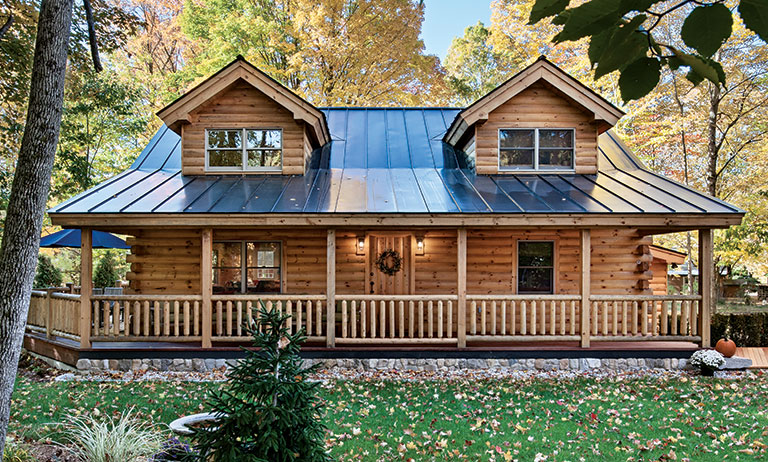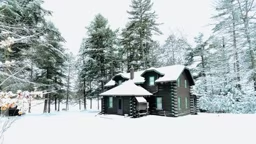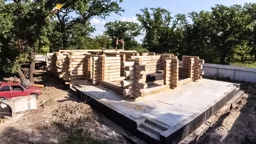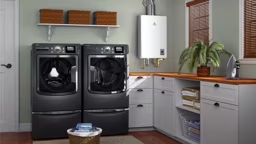The best and least expensive approach to conserving energy begins with your log home’s design. By using passive solar design techniques that have been known for thousands of years, you can reduce heating costs by as much as 50%. While taking full advantage of passive solar principles may take the involvement of a professional, you can easily cover the basics yourself. First come three “O’s” of passive solar design — orientation, openings, and overhangs.
Orientation
Start with the orientation of your home. Study your building site and note where the sun rises and sets in relation to your proposed home site. Note any obstructions that would shade your home during the day. In a cool climate, orient your home so the wall with the most windows (usually the great room) faces within 15 degrees of south. In a warmer climate, you may want to avoid a direct southern exposure. Swinging your home toward the east will allow it to capture more morning sun while blocking sunlight through the heat of the day and evening.Openings
Next consider the doors and windows in your floor plan. Concentrate the openings on the south-facing wall, followed by the east, north, and west walls. Calculate the total area of openings on each wall and compare with the total wall areas. At least half of your opening area should face south. In a climate zone where more heat is needed, your goal is to capture as much of the winter sun’s energy as possible while minimizing the heat radiated back to the outside. In a cooling climate, you want to selectively allow sunlight so that it won’t have an opportunity to overheat your house.Your choice of window also affects its solar efficiency. Three factors — all included in the sales literature and on the labels of reputable window manufacturers —provide the key to window selection: SHGC (Solar Heat Gain Coefficient), U-Factor, and VT (Visible Transmittance). If you plan to use energy from the sun to heat your home, the windows facing the sun should allow in as much solar energy as possible. For this they should have an SHGC greater than 0.6. You also want the window to be well insulated to prevent heat loss. This means a U-factor of 0.35 or less. (The lower the U factor the better its insulating ability.) Finally, since you usually want to see well through the window, look for a high VT.
In cooling climates, your window strategy will be different. Here you want to block most of the sun’s energy much of the time. Look for a lower SHGC and perhaps a lower VT. You may want to further enhance the heat-blocking characteristics of your windows by choosing those with Low-E (low emissivity) coatings, tintings or a reflective coating.

Overhangs
The third “O” stands for overhangs. Most homes today are built with minimal overhangs to simplify construction. But overhangs are about more than convenience and economy. Because the angle of the sun varies with the season, you can use overhangs to selectively admit sunlight during the low sun-angle winter months while blocking it during the high-angle summer months.
Passive Solar Design
People often talk about the contribution of thermal mass to the energy efficiency of log homes — they’re talking about the ability of logs to absorb and store heat. But there’s more to thermal mass than logs. Building materials such as stone, ceramic tile, and concrete all have the ability to capture and store heat, releasing it slowly over time.
Good passive solar design includes thermal mass storage inside the walls of the home to capture the sun’s energy for future use. Most log home owners have a potentially excellent source of thermal mass in their fireplace and chimney. The key is in its location.
To provide the greatest thermal mass benefit, locate stone or masonry fireplaces inside the heated envelope of the house where heat stored in the stones won’t be conducted to the outdoors. If possible, locate your fireplace where low-angle winter sun will shine directly on it while overhangs protect it from the high angle summer sun. You can create additional thermal mass by using tile or concrete for floor surfaces that are exposed to winter sun.
Once you’ve employed the principles of passive solar design in your home, you can turn to a variety of choices that affect your energy efficiency. These include insulation, heating and cooling equipment, hot water and appliances, and final sealing.
Insulation
If you are planning a solid log home you may wonder why the mention of insulation, since solid log walls provide their own insulation. However, you shouldn’t forget about your roof; many log homes have framed dormers and gables that require insulation as well. There are a variety of ways to insulate wall and roof cavities in your log home. Your choice can have a significant impact on both your heating and cooling bills.
Almost everyone is familiar with the fluffy fiberglass or mineral wool batts that are used to insulate framed walls and attics. This is probably the most popular and least expensive insulation used. Batt or blanket insulation can be very effective if it is installed correctly. Unfortunately, that’s a big if. Batt insulation is often installed by carpenters or drywall hangers whose mission is simply to “git ‘er done” so they can move on to something that itches less. This is a recipe for a poor insulation job with lots of voids and areas of compressed insulation where efficiency is compromised.
To properly use batts, the entire cavity should be filled without compressing the insulation. This means carefully ripping the batts in half to slip uncompressed insulation behind wires and electrical boxes. In some cases the insulation should be cut to allow it to remain uncompressed around electric switches or ductwork. If the insulation is faced with paper or foil, joints should be taped. When using paper faced batts, the paper edging should be stapled to the interior face of studs where wall coverings are attached to avoid creating air channels along the edge of studs.
Batts and blankets aren’t your only choices for insulation. Blown-in cellulose is often used in attic spaces and ceilings. Spray-in foam is more costly but provides excellent sealing and insulation, measuring even double or triple the efficiency of batts. Foams are generally divided into open or closed cell types: open-cell foams can absorb moisture while closed-cell foams are waterproof. Your choice is an important consideration since closed cell foams also act as a vapor barrier. If you use closed cell foam in your walls or roof you don’t want to install other vapor barriers because you’ll create a moisture trap that can lead to mold.
Log home roofs, especially those with exposed beams and cathedral ceilings, often use rigid foam sheets. In some cases the roof is made using SIPs (structural insulated panels) that consist of rigid foam sandwiched between “skins” of OSB or plywood. These can cover a roof quickly and provide superior insulating for your roof. Since these options carry a larger up-front cost, it’s important that your builder be familiar with how to install them. Discuss them with your builder or log provider.
Foundations present a special situation when it comes to insulation. Traditionally, most foundation walls use poured concrete or masonry block. If the walls are in contact with the surrounding soil, they can conduct heat out. The cooler walls can lead to condensation or uncomfortably high humidity in the basement. Adding rigid foam insulation around the outside of the foundation not only reduces heat loss, it turns your basement walls into thermal mass. Adding insulation to the inside of the walls reduces heat loss but without the mass gain.
There are a number of foundation alternatives that can improve the energy efficiency of your basement. Insulated Concrete Forms (ICFs) are foam forms that serve to hold concrete and remain in place after the walls are poured. These isolate the concrete from its surroundings providing insulation both inside and out. Pre-fabricated foundation walls often incorporate insulation and can be erected much more quickly than conventional foundation systems.
Vapor barriers are an important energy and health component in most wall and roof systems. Vapor barriers prevent the transmission of moisture-laden air into spaces where it might condense and create water or mold problems. A general rule of thumb in most climates is to include a vapor barrier between the insulation and interior living space. This may take the form of foil or paper-faced insulation (paper facing the interior), or polyethylene sheeting. Vapor barriers are especially important in cathedral ceilings covered with tongue-and-groove, where moist air may find its way into the roof cavity. There it can condense when it comes into contact with the cool roof surface and the condensation could soak into the insulation and destroy ceiling coverings.
Heating and Cooling
Heating and cooling costs account for about 56% of the energy costs for operating a home. So your choice of heating and cooling system can have a large effect on your monthly utility bills. Start by choosing EnergyStar rated equipment, which carries the highest efficiency ratings. Look for furnaces or boilers that carry a 90% or greater AFUE (Annual Fuel Use Efficiency) rating. Look for cooling equipment with a SEER (Seasonal Energy Efficiency Rating) of 13 or greater.
From a cost standpoint, heat pumps provide the most efficient systems in most climates. One set of equipment provides both heating and cooling. Because they rely on principles of heat exchange, heat pumps become less efficient as the temperature differences between outside and inside. In very cold climates, heat pumps can become costly to operate.
Geothermal heat pumps take the heat exchange technology one step farther. Instead of relying on the exchange of energy between inside and outside air, geothermal systems use ground air or more frequently water as an exchange medium. Several feet beneath the ground’s surface, temperatures remain fairly constant. Using ground water for heat exchange greatly increases the efficiency of the heat pump. In addition, constant ground temperatures (usually around 55-60 degrees year round) allow geothermal systems to function efficiently in much colder climates.
Heat pumps, furnaces and air conditioners rely on a system of ducts to deliver heated air throughout the house. Potential heat losses through ductwork mean that ductwork should be kept within the conditioned (heated and cooled) space of your home. Ductwork that runs through attics and crawlspaces must be carefully sealed and insulated.
Radiant flooring
Radiant floor heating does not require ductwork but relies instead on heated fluid circulated through tubes usually in concrete or wood floors. The fluid heats the floor, which in turn acts as a giant radiator. A heat sources for a radiant floor system includes a high efficiency boiler, a geothermal heat pump, or a solar hot water heater.
A drawback to radiant floor heating is that it doesn’t offer air conditioning. In climates where winters are cold and summers hot, additional cooling may be required. While adding to cost, you can accomplish this by adding a ductless mini-split system. Originally intended as a retro-fit for older non-air-conditioned homes, they’re a good choice for cooling a radiant heated home.
Water systems
Hot water accounts for about 13% of most people’s annual utility bill. Usually hot water is provided by an insulated tank fitted with a gas burner or electric heating elements. If going the traditional route, choose the highest efficiency units available. However, these are not your only choices.
If you live in an area with even a reasonable amount of sunshine, consider a solar hot water collector. This roof- or yard-mounted system circulates water or fluid through a panel where it’s warmed by the sun. The warmed fluid passes into an insulated storage tank where it can be drawn for use in radiant flooring or to heat drinking water. As a matter of health concern, drinking water usually doesn’t circulate through the collector directly; instead the heated water from the collector passes through a tank where it warms water used for drinking, bathing, and laundry.
You needn’t assume that cold climates rule out solar hot water. I recently spoke with a builder who recently installed a system and noted that it was delivering water at over 140 degrees on an overcast day when outside temperatures were 10 below zero and lower. However, cold-climate systems must be designed to prevent fluid freezing at night and on cold sunless days.
Tankless hot water systems skip storage of hot water and instead provide it only when needed. These wall-mounted gas units cost somewhat more than hot water heaters but eliminate the cost of continually maintaining a reservoir of hot water. When considering a tankless system, be sure to consider the amount of hot water you require. A household of four, all needing hot water at the same time can overpower a single system leaving someone to endure a cold shower. Multiple units or smaller dedicated units at the point of use eliminate this problem.
Appliances
Appliances and lighting account for about 34% of a homeowner’s annual energy bill. As you plan your home, there are a number of ways you can reduce this amount. Start by making sure all of your appliances carry an EnergyStar label. Whenever possible, use task lighting rather than general overhead illumination. The new compact fluorescent light bulbs have much better lighting characteristics and lifespan than their earlier predecessors. If you gave up on these a decade ago, give them another shot. In most homes the refrigerator is the most energy-intensive appliance. Look for the highest efficiency refrigerator you can find. Units made today are far superior to those made even a few years ago.
Sealants
When it comes to sealing your home, log homes are in a special category. Because the joints between logs offer an opportunity for serious air leakage, it’s especially important to follow the manufacturer’s sealing instructions carefully. Even when not called for in construction manuals, sealing horizontal log joints and corners with caulk or chinking on both the outside and inside generally results in much better energy performance.
A sure way to tell whether your home would benefit from additional sealing is have a blower door test conducted. This test measures the amount of air moving between the inside and outside of your house. It can identify trouble spots or indicate whether overall sealing is needed.
Keep the construction details
As a final step in building energy efficiency into your log home, make sure construction details such as overhangs and insulation details are included in your construction documents. Unless instructed otherwise most builders follow the rule of “the quicker and easier, the better.” Make sure they have a way of knowing what you have spent considerable time investigating. Study an example of your log provider’s construction documents and ask them to add details for insulation and overhangs if necessary.
Energy efficiency has become a buzzword in home design recently and it promises only to become more so. This is actually a good thing not only because it conserves precious resources and reduces pollution, but because it can also save you money. With the growing concern over energy, you don’t have to go it alone. A variety of businesses and agencies are now offering help ranging from advice to rebates on certain types of systems.







_11868_2023-04-27_10-18-256x288.avif)



